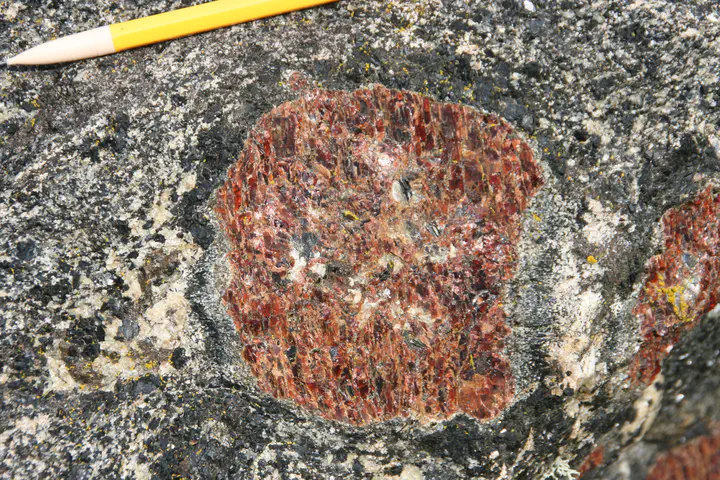Gore Mountain Garnet Amphibolite Records UHT Conditions: Implications for the Rheology of the Lower Continental Crust during Orogenesis
 ~ 5 cm radius garnets from the Gore Mountain Garnet Amphibolite (GMGA).
~ 5 cm radius garnets from the Gore Mountain Garnet Amphibolite (GMGA).
Abstract
The Gore Mountain Garnet Amphibolite (GMGA), part of the Mesoproterozoic Grenville Province in the Adirondack Highlands, NY, USA, is an iconic rock type known for hosting the world’s largest garnets (up to 1 m diameter). We present a new detailed petrographic study of these rocks. Field relations, whole-rock, and mineral major and trace element chemistry suggest that these rocks formed via a prograde hydration reaction of a metagabbro during an increase in pressure and temperature. Laser ablation inductively coupled plasma mass spectrometry U–Pb geochronology applied to zircon interpreted to be metamorphic in origin dates this reaction to 1053·9 ± 5·4 Ma (2σ; MSWD = 0·94), during the Ottawan Orogeny (1090–1020 Ma). Our results on peak metamorphic P–T conditions based on thermobarometry, diffusion models, and thermodynamic modelling indicate that these rocks formed at ultrahigh-temperature (>900 °C) conditions (P = 9–10 kbar, T = 950 ± 40 °C), significantly hotter than previously estimated. Diffusion models pinned by nearby cooling ages require the GMGA to initially cool quickly (9·1 °C Ma–1), followed by slower cooling (2·6 °C Ma–1). The two-stage cooling history for the GMGA could reflect initial advection-dominated cooling followed by conduction-dominated cooling once flow ceases. Our results suggest that the region was hot enough to undergo topography-driven lower crustal flow similar to that hypothesized for modern Tibet for 20–0 Ma (25–0 Ma when the effects of melt are included).